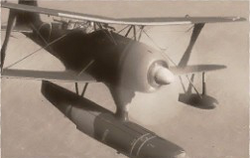The Mitsubishi F1M2 Type 0 Rei Kan (code name «Pete»), is a biplane fighter. It currently sits at Tier 0 in the Japanese line. It is a unique plane as it is the only "fighter" class aircraft in the game to feature a defensive turret. The upfront cost of a F1M2 is 1,000 ![]() .
.
Design, Development & Operational History[]
A single-engine all-metal biplane with a main central float and two additional underwing floats. It was originally built as a catapult-launched reconnaissance floatplane specializing in gunnery spotting for battleships and heavy cruisers of the Imperial Japanese Navy.
Flight tests of the first prototype Ka-17 (F1M1) aircraft (with a Nakajima Hikari 1 engine) were performed in June 1936. The tests showed that the seaplane had multiple issues, mostly having to do with poor directional stability. In addition, the F1M1's seaworthiness was doubtful.
Two years were spent performing a serious redesign. A new central float was built for the F1M, replacing the Nakajima E8N1 hydroplane float used on the prototypes. The Nakajima Hikari engine was replaced with a more powerful Mitsubishi Zuisei 13 fourteen-cylinder double-row air-cooled engine (the same as that used for Zero fighters) with a maximum take-off power of 875 hp. An improved version of the hydroplane, designated as the Type 0 Observation Seaplane Model 11 (F1M2), began full-scale production in 1940.
The F1M2 was armed with two 7.7mm Type 97 Model 3a synchronized fuselage-mounted machine guns with 500 rounds each, and one more 7.7mm Type 97 (Lewis Mk.III) machine gun with 582 rounds (6 standard magazines) was mounted in the turret in the observer’s cockpit to protect the rear of the plane from attacks from above. The lower wing panels had lugs installed to suspend two 60-kg, two 30-kg, or six 20-kg bombs.
At the beginning of the Pacific War, the F1M2s took part in the Battles for the Philippines, Papua New Guinea, and the Solomon Islands. The seaplanes were launched from floating bases and later from battleships, cruisers, and coastlines. The Rei Kans were used as scouts, gunnery spotters, light bombers, and anti-submarine aircraft. In June 1942, they were used as dive bombers over the Aleutian Islands; they also covered the Japanese positions there from the air as sea fighters.
A total of 1,118 F1M2s were manufactured, and their production was discontinued in March 1944. The aircraft remained in service until the end of the war.
In-Game Tactics[]
This plane is often neglected due to its weak structure and bulkiness (because of the floats), but like many Japanese planes, should not be underestimated. It can run as fast as most Reserves and Rank 0's, and can carry two 50kg bombs. It can also very easily defend itself, due to its impressive maneuverability and turret.
With care and gentle use of the controls, all floatplanes can "land" on a normal airstrip, and will respawn mid-air once repaired. Landing next to aircraft carriers also repair and rearm floatplanes.
| ||||||||||||||
